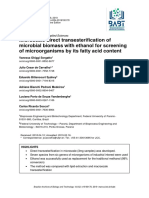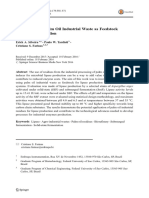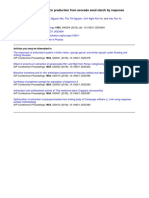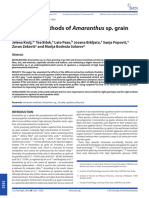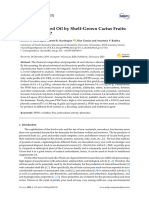Production of Lipase Using Cassava Peel and Sunflower Oil in Solid-State Fermentation - Preliminary Study
Production of Lipase Using Cassava Peel and Sunflower Oil in Solid-State Fermentation - Preliminary Study
Uploaded by
AgriculturaldavidCopyright:
Available Formats
Production of Lipase Using Cassava Peel and Sunflower Oil in Solid-State Fermentation - Preliminary Study
Production of Lipase Using Cassava Peel and Sunflower Oil in Solid-State Fermentation - Preliminary Study
Uploaded by
AgriculturaldavidOriginal Title
Copyright
Available Formats
Share this document
Did you find this document useful?
Is this content inappropriate?
Copyright:
Available Formats
Production of Lipase Using Cassava Peel and Sunflower Oil in Solid-State Fermentation - Preliminary Study
Production of Lipase Using Cassava Peel and Sunflower Oil in Solid-State Fermentation - Preliminary Study
Uploaded by
AgriculturaldavidCopyright:
Available Formats
Journal of Agricultural Science and Technology A 3 (2013) 948-954 Earlier title: Journal of Agricultural Science and Technology, ISSN
1939-1250
DAVID
PUBLISHING
Production of Lipase Using Cassava Peel and Sunflower Oil in Solid-State Fermentation: Preliminary Study
Caroline Branco Gerber1, Francieli Kaufmann1, Gabrieli Nicoletti1, Marlia Dalla Costa1 and Aniela Pinto Kempka2
1. Volunteer Scholarship Holder of the Scientific Initiation, Food Engineering Department, State University of Santa Catarina, Pinhalzinho 89870-000, Santa Catarina, Brazil 2. Food Engineering Department, State University of Santa Catarina, Pinhalzinho 89870-000, Santa Catarina, Brazil
Received: August 2, 2013 / Published: December 20, 2013. Abstract: Full use of residues from industrial processes is a fundamental necessity of contemporary society, since it avoids impacts to the environment by using residues as inputs for other products of high economic and social importance. In this study, lipase production of the crude enzymatic extracts obtained by Aspergillus niger using cassava peel as substrate and sunflower oil as an inductor was investigated. The optimized cultivation temperature and concentration of inductor were determined using the response surface methodology. The two variables studied exercised influence in the production of lipase in the 95% level of confidence. The response surface obtained indicated that the conditions that maximize lipase activity production were 30.5 C and initial concentration of sunflower oil was 2.5% (w/w). Through this analysis, it is evident that extremes in temperature and concentration of inductor tend to decrease lipase production, since low temperatures decrease metabolism and high temperatures may inactivate the lipase. Optimum lipase yield was 59.8 U/g of dry peel which was fermented for 60 h. Lipase production presents a peak of 61.3 U/g, at 72 h of fermentation. However, this value is statistically equal (p > 0.05) of the value of lipase activity obtained for 60 h and 84 h of fermentation. Key words: Cassava peel, lipase, production, solid-state fermentation, sunflower oil.
1. Introduction
Cassava, Manihot esculenta Crantz (Euphorbiaceae), is a perennial shrub belonging to the family of Euphorbiaceae. The genus Manihot comprises 98 species of which M. esculenta is the most widely cultivated member. The tuberous root of cassava is the fourth most important food source of carbohydrate in the tropics after rice, maize and sugar cane, due to its high starch content [1]. Production of cassava (Manihot esculenta Crantz) starch results in creation of around 10%-15% of the original root weight as solid waste [2], and maybe results in using fermentation processes. Bioprocessing based on
Corresponding author: Aniela Pinto Kempka, Ph.D., research fields: enzyme, bioprocess, food and residues. E-mail: aniela.kempka@udesc.br.
microbial conversion is an important approach for the production of value-added products from cassava [3], including the production of enzymes. Cassava peel is a byproduct of cassava processing either to food or other industrial products. This peel could make up to 10%-20% of the weight of the roots, thus indicating its enormous potential for biotechnological processes [4]. The major share of the industrial enzyme market is occupied by hydrolytic enzymes, such as proteases, amylases, esterases and lipases [5]. Lipases, triacylglycerol ester hydrolases (EC 3.1.1.3) are ubiquitous enzymes that catalyze the breakdown of fats and oils with subsequent release of free fatty acids, diacylglycerols, monoacylglycerols, glycerol and reactions of esterification, transesterification and
Production of Lipase Using Cassava Peel and Sunflower Oil in Solid-State Fermentation: Preliminary Study
949
interesterification of lipids [6, 7]. Promising applications about lipases are found in organic chemical processing, detergent formulations, synthesis of biosurfactants, the oleochemical industry, the dairy industry, the agrochemical industry, paper manufacture, nutrition, cosmetics and pharmaceutical processing [8]. Microbial lipases are mostly extracellular and are greatly influenced by nutritional and physico-chemical factors, such as temperature, pH, nitrogen and carbon sources, presence of lipids, inorganic salts, agitation and dissolved oxygen concentration [5], and also may be used submerse fermentation or solid-state fermentation (SSF). When developing industrial fermentation, designing media and optimizing fermentation conditions are of critical importance, because these factors could strongly interfere with the yield of lipase production. Experimental design techniques present a more balanced alternative to the one-factor-at-a-time
the techniques to be used account for these interactions, so that a set of optimal process conditions can be determined [13]. Response surface methodology (RSM) is an effective statistical technique for the investigation of complex processes. The main advantage of RSM is the reduced number of experimental runs needed to provide sufficient information for statistically acceptable result. It is a faster and less expensive method for gathering research result than the classical method [14]. In this study, RSM was used to optimize lipase production by Aspergillus niger, using cassava peel as substrate and sunflower oil as inductor. A 22 central composite rotatable design (CCRD) was used to optimize fermentation conditions to verify the possibility of using cassava peel as substrate and sunflower oil as inductor.
2. Materials and Methods
2.1 Microbial Culture and Inoculum Preparation Aspergillus niger was obtained from Fundao Andr Tosello culture collection. The propagation of spores prior to fermentation was carried out for seven days at 27.5 C in a medium constituted by potato dextrose agar (PDA) 3.9% (w/v) and distilled water. Medium for inoculum production consisted of (w/v): 2% starch, 1% olive oil, 0.1% yeast extract, 0.025% MgSO47H2O, 0.05% KH2PO4, 0.5% CaCO3 and 1.5% agar. This medium was inoculated with a spore suspension and incubated at 27 C for seven days. The spores were collected adding 10 mL of a sterile 0.1% Tween 80 aqueous solution and glass beads to the fermented agar medium and kept at 4 C until use [11]. 2.2 Preparation of the Substrate and the SSF Cassava peel was used as substrate and was previously comminuted and dried in the drying oven (Solab) at the temperature of 105 C for 24 h and subsequently frozen for maintaining their physicochemical characteristics. Inducer was used as
approach for fermentation improvement [9]. SSF is defined as the fermentation process on moist solid substrate in the absence or near absence of free water. SSF can be used for the production of enzymes utilizing various substrates including solid wastes [10]. The use of agro-industrial residues as substrate in lipase production by SSF can significantly reduce the final price of enzyme, and also add value to low cost materials in the market [11]. Many studies have been undertaken to define the optimal culture and nutritional requirements for lipase production. These requirements are influenced by the type and concentration of the carbon and nitrogen sources, culture pH and growth temperature. Lipidic carbon sources generally seem to be essential to obtain a high lipase yield, although a few authors observed that the presence of fats and oils was not statistically significant for enzyme production [12]. It is noteworthy that during fermentation, the operating conditions interact and influence their respective effects on the response. It is important that
950
Production of Lipase Using Cassava Peel and Sunflower Oil in Solid-State Fermentation: Preliminary Study
sunflower oil (Salada) (the vegetable oil was considered a supplementary carbon source since their composition is mainly constituted by lipids). The experiments for lipase production were carried out aseptically in conical reactors covered with hydrophobic fabric. Aqueous solution containing the supplements was added to the substrate and the resulting medium was then sterilized at 121 C for 20 min. The sterile medium was then inoculated with 108 spores/g dry substrate using spore suspension previously prepared. Cultivation was carried out in an incubator BOD (Solab). The moisture of the medium was set at 55% in accordance with Kempka et al. [11]. 2.3 RSM and Optimization of Lipase Production A factorial design with two factors and four axial points (22 CCRD) was carried out to evaluate the effect of incubation temperature and concentration of inductor (%, w/w) on lipase production. Table 1 shows the values of the variables and their respective levels coded (in brackets). Each assay was carried out in duplicate and a center point was performed in triplicate for experimental error evaluation. A five-level, two-factor CCRD was employed, requiring 10 experiments. The fractional factorial design consisted of three factorial points, two axial points and two central points. The data obtained were fitted to a second-order polynomial equation. The analysis was performed using software Statistica 10.0Statsoft Inc.. 2.4 Extraction and Determination of Lipase Enzyme Activity and Biomass Determination The fermented medium was weighed, added to 45 mL of 0.1 mol/L sodium phosphate buffer at pH 7.0 and incubated at 35 C and 200 rpm for 30 min for enzyme extraction. Following the extraction, the liquid fraction was separated by filtration and assayed for lipase activities. Lipase activity was determined by titration method. An emulsion of olive oil (10% w/v) and arabic gum (5% w/v) in sodium
phosphate buffer 0.1 mol/L and pH 7.0, was incubated with a sample of the enzymatic extract at 37 C and 160 rpm for 15 min. The reaction was stopped and the fat acids were extracted with a solution of acetone and ethanol (1:1). The fatty acids produced were titrated with NaOH (0.05 mol/L) [15]. One unit of lipase activity was defined as the amount of enzyme that produced 1 mol of fatty acids/min, under the assay conditions. 2.5 Physicochemical Characterization of Cassava Peel The physicochemical characterizations of cassava peel, such as pH, moisture, ash and starch were analyzed. For the determination of pH, 5 g of peel homogenized in 5 mL distilled water were used and preceded with the reading digital potentiometer (Quimis). For the moisture determination, the authors used the gravimetric method. For the determination of ash, incineration was used in a muffle at 550 C and for determination of starch, the authors used the method of acid digestion and determination of sugars reducers [16].
3. Results and Discussion
Physicochemical characterizations of cassava peel were obtained before drying, such as humidity value 72.26%, ash 2.27%, pH 6.0 and starch 56.5%, proving that cassava peel is an appropriate substrate for fermentation. The lipase production was possible in this way due to the supplementation of sunflower oil, characterized as an inducer in the process. 3.1 Optimization of Lipase Production Table 2 presents the matrix of the complete factorial design with the lipase activity obtained at 60 h of fermentation. The highest lipase production, showed higher amount of lipase activity occurred to the center point of the experiment, with mean lipase activity of 59.8 U/g, at a temperature of 30.5 C and the percentage of inductor 2.5 (w/w). Tukey test can verify
Production of Lipase Using Cassava Peel and Sunflower Oil in Solid-State Fermentation: Preliminary Study Table 1 Factorial design with two factors and four axial points (22) was carried out to evaluate the effect of incubation temperature and concentration of inductor (%, w/w) on lipase production using cassava peel and sunflower oil. Experiment E1 E2 E3 E4 E5 E6 E7 E8 E9 (C) E10 (C) Temperature (C) 25 (-1) 25 (-1) 36 (1) 36 (1) 22.7 (-1.41) 38.2 (1.41) 30.5 (0) 30.5 (0) 30.5 (0) 30.5 (0) Concentration of inductor (%, w/w) 1.0 (-1) 4.0 (1) 1.0 (-1) 4.0 (1) 2.5 (0) 2.5 (0) 0.4 (-1.41) 4.6 (1.41) 2.5 (0) 2.5 (0)
951
may be related to the characteristics of that mode of cultivation, if compared to the submerged one. In the SSF, the final product is concentrated and fungi have the appropriate characteristics for the bioprocess such as tolerance to low water activities and production of enzymes by the hyphae [17]. The use of agro-industrial residues as the substrate could result in a reduction in the costs of lipase production, considering that the culture medium usually represents 25%-50% of the total production costs [18]. The production of lipase is mostly inducer dependent; in many cases, oils act as good inducers of the enzyme. The requirement of sugar as a carbon source in addition to lipids varies with the microorganism. In general, media supplemented with glucose along with triglycerides stimulate maximum lipase production in the case of fungi [9]. As an example, the lipase production by Yarrowia lipolytica resulted in activity of 69 U/g when using ground peanut as substrate [19]. The profiles of lipase production (in terms of lipase activity) for all experiments in the study are shown in Fig. 1. It can be seen that the lipase activity increased throughout the fermentation process, except for the experiments E1, E4 and E5 (Fig. 1a) that from the 48 h remained constant. All experiments of Fig. 1b show increased lipase activity over the 60 h of fermentation. The enzyme productivity was also determined in 60 h of fermentation being achieved 0.99 U/g h (central point). The value is higher that obtained by Kempka et al. [11], 0.74 U/g h in 72 h of fermentation using Penicillium verrucosum, by Gutarra et al. [20], 0.26 U/g h in 72 h of fermentation and by Mahadik et al. [21], 0.87 U/g in 144 h of fermentation using Aspergillus niger and wheat bran/sunflower oil as substrate. The statistical analysis of the results allowed fitting a coded empirical model relating lipase activity (equation) to temperature and inductor. The ANOVA analyses for lipase activity showed high correlation coefficient and a good performance of the F-test for regressions. Therefore, the equation is predictive of lipase
Table 2 Matrix of the experimental design (real values) with responses in terms of lipase activity for lipase production using cassava peel and sunflower oil. Temperature Inductor Lipase activity (U/g) (C) (%, w/w) standard deviation E1 25 1.0 18.87b 2.88 E2 25 4.0 28.49ab 0.84 E3 36 1.0 43.80de 0.97 E4 36 4.0 26.37ab 1.59 E5 22.7 2.5 31.18ac 1.61 E6 38.2 2.5 42.33cde 5.52 E7 30.5 0.4 48.33ef 2.36 E8 30.5 4.6 34.69acd 3.92 E9 (C) 30.5 2.5 58.87fg 4.21 E10 (C) 30.5 2.5 60.83g 1.18 Mean lipase activity followed by different letters differ significantly with 95% confidence (p < 0.05) by Tukey test. Experiment
that the result of the experiment E10 differs significantly (p < 0.05) from all the other experiments, and the experiment E9 differs from the others (p < 0.05) except for the experiment E7. In the experiments E7, E9 and E10, the same process was used (temperature being 30.5 C), differing in relation to the percentage of the inductor. Colla et al. [17] who studied the lipase production using soybean and rice husk obtained 22.5 U/g of lipase activity. Contesini et al. [18] obtained 33.03 U/g of lipase activity using wheat bran as substrate. In the two studies cited, the micro-organisms used were Aspergillus niger. The highest lipolytic activities obtained in the SSF
952
Production of Lipase Using Cassava Peel and Sunflower Oil in Solid-State Fermentation: Preliminary Study
(a) (b) Fig. 1 Profiles lipase activity over 60 hours of fermentation using A. niger and cassava peel supplemented with sunflower oil (inductor).
production in the investigated range of factors.
LA -487.48 31.21T 49.08I 0.46T 2 5.27 I 2 0.82TI
where, LA denotes lipase activity (U/g dry substrate), T is the temperature, and I the perceptual inductor content. The graph of predicted and observed values for the empirical model shown in Fig. 2, shows a good correlation between theoretical values and those obtained in practice (R = 0.92). Biological processes are highly complex and the enzyme production depends on the interaction of several processes influencing microbial cellular metabolism [13]. Fig. 3 shows a Pareto Chart obtained from experimental results of the lipase activity. It is observed that both the temperature and the inductor have significant effect on lipase production. Separately, the temperature influenced significantly positive and the percentage of inductor has significant negative effect, which means the increase of temperature and decrease in the percentage of inductor lead to increased lipase activity. However, from the interaction between the variables, it can be seen that the significant effect was negative and quadratic terms also have significant negative effects. The 3D response surface plot is the graphical representations of the regression equation used to investigate the interaction among variables and to determine the optimum concentration of each factor
Fig. 2 Correlation between observed and predicted values by the mathematical model.
Fig. 3 Pareto chart obtained from experimental results of the lipase activity.
Production of Lipase Using Cassava Peel and Sunflower Oil in Solid-State Fermentation: Preliminary Study
953
for maximum lipase [13]. The 3D plots shown in Fig. 4 were based on the function of two variables at its optimum level. This surface indicates that the conditions that maximize lipase activity production are 30.5 C and inductor of 2.5% (w/w). Through this analysis it is evident that extremes in temperature and inductor tend to decrease lipase production, since low temperatures decrease metabolism and high temperatures may inactivate the lipase. Fig. 5 shows the lipase production for optimum cultivation conditions. Lipase production presents a peak of 61.3 U/g at 72 h of fermentation. However, this value (61.3 U/g) does not differ statistically (p > 0.05) by Tukey test with the values of lipase activity obtained for 60 h of fermentation and 84 h of fermentation. It can be concluded that the time of 60 h is sufficient to maximize the production of lipase by A. niger using cassava peel/sunflower oil (2.5% w/w) as a substrate and temperature of 30.5 C. In the study of Contesini et al. [18], all the experiments were carried out for 72 , 96 and 120 h. Maximum activity was reached after 96 h for all assays, and after this, a decrease occurred in activity. When Kaushik et al. [22] studied about lipase production using Aspergillus carneus and the methodology response surface, they obtained the concentration of sunflower oil 1%, temperature 37 C and incubation time of 96 h, in addition to other optimal conditions.
(b) Fig. 4 Response surface for lipase activity as a function of inductor and temperature.
(a)
4. Conclusions
The fungus Aspergillus niger showed a good performance in the enzyme production. Lipase activity values of 59.8 U/g at 60 h of fermentation and 61.3 U/g at 72 h of fermentation in the optimized operational conditions (T = 30.5 C, inductor = 2.5%) were obtained. The response surface methodology is an efficient methodology to identify the significant variables and to optimize factors using a minimum number of experiments for lipase production. More studies are needed to complement the present study.
Fig. 5 time.
Lipase production under optimal conditions along
References
[1] I.S. Blagbrough, S.A.L. Bayoumi, M.G. Rowan, J.R. Beeching, Cassava: An appraisal of its phytochemistry and its biotechnological prospects, Phytochemistry 7
954
Production of Lipase Using Cassava Peel and Sunflower Oil in Solid-State Fermentation: Preliminary Study [13] A. Salihu, M.Z. Alam, M.I. AbdulKarim, H.M. Salleh, Effect of process parameters on lipase production by Candida cylindracea in stirred tank bioreactor using renewable palm oil mill effluent based medium, Journal of Molecular Catalysis B: Enzymatic 72 (2011) 187-192. [14] E.R. Gunawan, M. Basri, M.B.A. Rahman, A.B. Salleh, R.N.Z.A. Rahman, Study on response surface methodology (RSM) of lipase-catalyzed synthesis of palm-based wax ester, Enzyme and Microbial Technology 37 (2005) 739-744. [15] D.M.G. Freire, E.M.F. Teles, E.P.S. Bon, G.L. Santanna Jr., Lipase production by Penicillium restrictum in a laboratory scale fermentor: Media composition, agitation and aeration, Biotechnology and Applied Biochemistry 63 (1997) 409-421. [16] Adolfo Lutz Institute, Physico-Chemical Methods for Food Analysis, 4th ed., IMESP, So Paulo, 2008, p. 1020. (in Portuguese)
[2]
(2010) 1940-1951. K. Sriroth, R. Chollakup, S. Chotineeranat, K. Piyachomkwan, C.G. Oates, Processing of cassava waste for improved biomass utilization, Bioresource Technology 71 (2000) 63-69. [3] U. Rattanachomsri, S. Tanapongpipat, L. Eurwilaichitr, V. Champreda, Simultaneous non-thermal saccharification of cassava pulp by multi-enzyme activity and ethanol fermentation by Candida tropicalis, Journal of Bioscience and Bioengineering 107 (2009) 488-493. [4] P. Jamal, R.I.D. Tijani, M.Z. Alam, M.E.S. Mirghani, Effect of operational parameters on solid state fermentation of cassava peel to an enriched animal feed, Journal of Applied Sciences 12 (2012) 1166-1170. [5] R. Gupta, N. Gupta, P. Rathi, Bacterial lipases: An overview of production, purification and biochemical properties, Applied Microbiology and Biotechnology 64 (2004) 763-781. [6] P. Villeneuve, J.M. Muderhwa, J. Graille, M.J. Haas, Customizing lipases for biocatalysis: A survey of chemical, physical and molecular biological approaches, Journal of Molecular Catalysis B: Enzymatic 9 (2000) 113-148. [7] A. Salihu, M.Z. Alam, M.I. AbdulKarim, H.M. Salleh, Lipase production: An insight in the utilization of renewable agricultural residues, Resources, Conservation and Recycling 58 (2012) 36-44. [8] R. Sharma, Y. Chisti, U.C. Banerjee, Production, purification, characterization, and applications of lipases, Biotechnology Advances 19 (2001) 627-662. [9] A. Rajendran, V. Thangavelu, Statistical experimental design for evaluation of medium components for lipase production by Rhizopus arrhizus MTCC 2233, LWT-Food Science and Technology 42 (2009) 985-992. [10] A. Santis-Navarro, T. Gea, R. Barrena, A. Snchez, Production of lipases by solid state fermentation using vegetable oil-refining wastes, Bioresource Technology 102 (2011) 10080-10084. [11] A.P. Kempka, N.L. Lipke, T.L.F. Pinheiro, S. Menoncin, H. Treichel, D.M.G. Freire, et al., Response surface method to optimize the production and characterization of lipase from Penicillium verrucosum in solid-state fermentation, Bioprocess and Biosystems Engineering 31 (2008) 119-125. [12] F.J. Contesini, D.B. Lopes, G.A. Macedo, M. da G. Nascimento, P. de O. Carvalho, Aspergillus sp. lipase: Potential biocatalyst for industrial use, Journal of Molecular Catalysis B: Enzymatic 67 (2010) 163-171.
[17] L.M. Colla, J. Rizzardi, M.H. Pinto, C.O. Reinehr, T.E.
Bertolin, J.A.V. Costa, Simultaneous production of lipases and biosurfactants by submerged and solid-state bioprocesses, Bioresource Technology 101 (2010) 8308-8314.
[18] F.J. Contesini, V.C. Silva, R.F. Maciel, R.J. Lima, F.F.
Barros, P.O. Carvalho, Response surface analysis for the production of an enantioselective lipase from Aspergillus niger by solid state fermentation, Journal of Microbiology 5 (2009) 563-571. E. Rigo, J.L. Ninow, M. Di Luccio, J.V. Oliveira, A.E. Polloni, D. Remonatto, et al., Lipase production by solid fermentation of soybean meal with different supplements, LWT-Food Science and Technology 43 (2010) 1132-1137. M.L.E. Gutarra, L.R. Castilho, D.M.G. Freire, G.L. Santanna Jr., Lipase production by solid-state fermentation: Cultivation conditions and operation of tray and packed-bed bioreactors, Applied Biochemistry and Biotechnology 121 (2005) 105-116. N.D. Mahadik, U.S. Puntambekar, K.B. Bastawde, J.M. Khire, D.V. Gokhale, Production of acidic lipase by Aspergillus niger in solid state fermentation, Process Biochemistry 38 (2002) 715-721. R. Kaushik, S. Saran, J. Isar, R.K. Saxena, Statistical optimization of medium components and growth conditions by response surface methodology to enhance lipase production by Aspergillus carneus, Journal of Molecular Catalysis B: Enzymatic 40 (2006) 121-126.
[19]
[20]
[21]
[22]
You might also like
- GE 1 Understanding The Self MODULEDocument148 pagesGE 1 Understanding The Self MODULEKirstine Valerie Mandalones92% (36)
- Production and Optimization of Lipase From Candida Rugosa Using Groundnut Oilcake Under Solid State FermentationDocument7 pagesProduction and Optimization of Lipase From Candida Rugosa Using Groundnut Oilcake Under Solid State FermentationInternational Journal of Research in Engineering and TechnologyNo ratings yet
- 1 s2.0 S2352484719306584 MainDocument5 pages1 s2.0 S2352484719306584 MainDwini PutriNo ratings yet
- Proximate Analysis of Cold-Press Oil Cakes After Biological Treatment With Trametes Versicolor and Humicola GriseaDocument8 pagesProximate Analysis of Cold-Press Oil Cakes After Biological Treatment With Trametes Versicolor and Humicola GriseaJeri PradinataNo ratings yet
- A Novel Application of Solid State Culture Production of Lipases byDocument5 pagesA Novel Application of Solid State Culture Production of Lipases byasep muhamadNo ratings yet
- 1 1 17.1 PDFDocument4 pages1 1 17.1 PDFCamila CobosNo ratings yet
- MicrobiologyDocument5 pagesMicrobiologygodfrey omariNo ratings yet
- Aspergillus TerreusDocument6 pagesAspergillus Terreusgodfrey omariNo ratings yet
- Microbial Removal of FOGDocument7 pagesMicrobial Removal of FOGIzzat RozaliNo ratings yet
- Artículo PDFDocument7 pagesArtículo PDFEric Adiel Lona GaribayNo ratings yet
- Fermentation and Recovery of L-Glutamic - Acid - FromDocument8 pagesFermentation and Recovery of L-Glutamic - Acid - FromPrachi Bhoir100% (1)
- Microscale Direct Transesterification of Microbial Biomass With Ethanol For Screening of Microorganisms by Its Fatty Acid ContentDocument11 pagesMicroscale Direct Transesterification of Microbial Biomass With Ethanol For Screening of Microorganisms by Its Fatty Acid ContentyutefupNo ratings yet
- Camargo 2014Document8 pagesCamargo 2014Julio MoralesNo ratings yet
- 2011 Basheer Et Al Aspergillus Awamori Lipase ProductionDocument12 pages2011 Basheer Et Al Aspergillus Awamori Lipase ProductiontigapeptindonesiaNo ratings yet
- Production of Acetone-Butanol-ethanol From Spoilage Date PalmDocument7 pagesProduction of Acetone-Butanol-ethanol From Spoilage Date PalmI-Twins RgnNo ratings yet
- Pineapple Peel Waste For Bioethanol ProductionDocument1 pagePineapple Peel Waste For Bioethanol ProductionAnge Cantor-dela CruzNo ratings yet
- Mehanni Et Al-2016-Journal of Food BiochemistryDocument6 pagesMehanni Et Al-2016-Journal of Food BiochemistryAdriana Fernandez HerreroNo ratings yet
- Production of Ethanol From The Hemicellulosic Fraction of Sunflower Meal BiomassDocument7 pagesProduction of Ethanol From The Hemicellulosic Fraction of Sunflower Meal BiomassJulio MoralesNo ratings yet
- Valorization of Palm Oil Industrial Waste As Feedstock For Lipase ProductionDocument14 pagesValorization of Palm Oil Industrial Waste As Feedstock For Lipase ProductionMangasa SiregarNo ratings yet
- Minitab17 GettingStarted enDocument6 pagesMinitab17 GettingStarted enTan Hau VoNo ratings yet
- tmp50B7 TMPDocument11 pagestmp50B7 TMPFrontiersNo ratings yet
- Extraction and Characterization of Guava Seed Oil - A Novel Industrial ByproducDocument9 pagesExtraction and Characterization of Guava Seed Oil - A Novel Industrial ByproducDevita AmeliaNo ratings yet
- Jurnal Lipase Abraham Mora PDFDocument6 pagesJurnal Lipase Abraham Mora PDFAbraham Mora TumanggorNo ratings yet
- Lipase Production by Geotrichum Candidum-M2Document5 pagesLipase Production by Geotrichum Candidum-M2AparnaNo ratings yet
- Bioresources.: Vanillin Production by Phanerochaete Industrial Husk in Solid State FermentationDocument9 pagesBioresources.: Vanillin Production by Phanerochaete Industrial Husk in Solid State FermentationileanaNo ratings yet
- Katalis PDFDocument13 pagesKatalis PDFkhansarafidaNo ratings yet
- Rhizopus Oryzae: Production of L-Lactic Acid From Starch and Food Waste by Amylolytic MTCC 8784Document11 pagesRhizopus Oryzae: Production of L-Lactic Acid From Starch and Food Waste by Amylolytic MTCC 8784Christin SimamoraNo ratings yet
- Biosynthesis, Characterization and Enzymatic Transesteri Cation of Single Cell Oil of Mucor Circinelloides - A Sustainable Pathway For Biofuel ProductionDocument7 pagesBiosynthesis, Characterization and Enzymatic Transesteri Cation of Single Cell Oil of Mucor Circinelloides - A Sustainable Pathway For Biofuel Productionveliger100No ratings yet
- Artigo LipaseDocument11 pagesArtigo LipaseRikson SouzaNo ratings yet
- Avoir 169797Document12 pagesAvoir 169797Hana HanounaNo ratings yet
- J Sci Food Agric - 2015 - Krulj - Extraction Methods of Amaranthus SP Grain Oil IsolationDocument7 pagesJ Sci Food Agric - 2015 - Krulj - Extraction Methods of Amaranthus SP Grain Oil IsolationRoxana AlinNo ratings yet
- 2011 Godoy Et Al Penicillium Simplicissimum Lipase For BiodieselDocument9 pages2011 Godoy Et Al Penicillium Simplicissimum Lipase For BiodieseltigapeptindonesiaNo ratings yet
- Brazilian Journal of MicrobiologyDocument7 pagesBrazilian Journal of MicrobiologyHimaniNo ratings yet
- Suyanto 2019 J. Phys. - Conf. Ser. 1374 012005Document7 pagesSuyanto 2019 J. Phys. - Conf. Ser. 1374 012005Fina Mustika SimanjuntakNo ratings yet
- Biocatalysis and Agricultural Biotechnology: SciencedirectDocument8 pagesBiocatalysis and Agricultural Biotechnology: SciencedirectAyush SinghNo ratings yet
- Microwave-Assisted Extraction and Physicochemical Evaluation of Oil From Hevea Brasiliensis SeedsDocument12 pagesMicrowave-Assisted Extraction and Physicochemical Evaluation of Oil From Hevea Brasiliensis SeedsSenuke TestNo ratings yet
- Comparative Study of Biosurfactants Production Bybacillus Licheniformis and CandidaDocument7 pagesComparative Study of Biosurfactants Production Bybacillus Licheniformis and CandidaCatalinaManjarresNo ratings yet
- A Single-Host Fermentation Process For The Production of Avor Lactones From Non-Hydroxylated Fatty AcidsDocument10 pagesA Single-Host Fermentation Process For The Production of Avor Lactones From Non-Hydroxylated Fatty Acidsoki trisnaNo ratings yet
- 1 s2.0 S1876610214016622 Main PDFDocument7 pages1 s2.0 S1876610214016622 Main PDFJhoao VelaNo ratings yet
- Analysis of Rhamnolipid Biosurfactants Produced-OrangeDocument12 pagesAnalysis of Rhamnolipid Biosurfactants Produced-OrangeAdrian Bermudez LoeraNo ratings yet
- Passiflora Edulis Seed Oil From West Cameroon - Chemical Characterization and Assessment of Its Hypolipidemic Effect in High Fat Diet-Induced RatsDocument8 pagesPassiflora Edulis Seed Oil From West Cameroon - Chemical Characterization and Assessment of Its Hypolipidemic Effect in High Fat Diet-Induced RatsZokou RoniceNo ratings yet
- Optimization of Cellulase Enzyme From Vegetable Waste by Using Trichoderma Atroviride in Solid State FermentationDocument6 pagesOptimization of Cellulase Enzyme From Vegetable Waste by Using Trichoderma Atroviride in Solid State FermentationIOSRjournalNo ratings yet
- Unit I Production and Application of Enzymes SN JainDocument5 pagesUnit I Production and Application of Enzymes SN JainSuraj PatilNo ratings yet
- (Honorato Et Al., 2007) Fermentation of Cashew Apple Juice To Produce High Added Value ProductsDocument7 pages(Honorato Et Al., 2007) Fermentation of Cashew Apple Juice To Produce High Added Value ProductsRosane CavalcanteNo ratings yet
- Passion Fruit Seed Oil As Alternative Feedstock For Biodiesel Production Via TransesterificationDocument4 pagesPassion Fruit Seed Oil As Alternative Feedstock For Biodiesel Production Via TransesterificationSEP-PublisherNo ratings yet
- Processing: Abstracts May 5-8, 2019Document22 pagesProcessing: Abstracts May 5-8, 2019Adufe RufaiNo ratings yet
- 4 - Choubane S., Khelil O. Et Cheba B. 2015, African Journal of BiotechnologyDocument6 pages4 - Choubane S., Khelil O. Et Cheba B. 2015, African Journal of BiotechnologyOmar KHELILNo ratings yet
- Use of Various Coffee Industry Residues The Cultivation of in Solid State FermentationDocument12 pagesUse of Various Coffee Industry Residues The Cultivation of in Solid State FermentationVanesa CaroNo ratings yet
- Utilization of Oil Palm Empty Fruit Bunch Hydrolysate For Ethanol Production by Baker's Yeast and Loog-PangDocument6 pagesUtilization of Oil Palm Empty Fruit Bunch Hydrolysate For Ethanol Production by Baker's Yeast and Loog-PangDadadaNo ratings yet
- Rhodototula Glutinis BiodieselDocument5 pagesRhodototula Glutinis BiodieseljrmattarNo ratings yet
- Bioremediartion of HydrocarbonDocument7 pagesBioremediartion of HydrocarbonH CcaNo ratings yet
- Processes 08 00132 v2Document11 pagesProcesses 08 00132 v2foodengineeringlaboratoryNo ratings yet
- Solid and Liquid Pineapple Waste Utilization For Lactic Acid Fermentation USING Lactobacillus DelbrueckiiDocument3 pagesSolid and Liquid Pineapple Waste Utilization For Lactic Acid Fermentation USING Lactobacillus Delbrueckiipatrica_23velezNo ratings yet
- A 2012 028 Original Paper pp23 29Document7 pagesA 2012 028 Original Paper pp23 29Sahil KumarNo ratings yet
- Anti Fungal in BreadDocument6 pagesAnti Fungal in BreadRufa Lara MendezNo ratings yet
- Main Text and Data-BJMDocument33 pagesMain Text and Data-BJMrodolforibasNo ratings yet
- Repeated PH-stat Fed-Batch Fermentation For RhamnolipidDocument9 pagesRepeated PH-stat Fed-Batch Fermentation For Rhamnolipidsidikmar1425No ratings yet
- Enhanced Lactic Acid Production From Carob Extract by Lactobacillus Casei Using Invertase Pretreatment PDFDocument12 pagesEnhanced Lactic Acid Production From Carob Extract by Lactobacillus Casei Using Invertase Pretreatment PDFRafael RubioNo ratings yet
- Starter Cultures in Food ProductionFrom EverandStarter Cultures in Food ProductionBarbara SperanzaNo ratings yet
- Advances in Dairy ProductsFrom EverandAdvances in Dairy ProductsFrancesco ContoNo ratings yet
- Bahasa Inggris 8Document77 pagesBahasa Inggris 8Anis Syafitri100% (1)
- 1800 Calorie Meal PlanDocument5 pages1800 Calorie Meal PlanMariana Angeles100% (1)
- Imo Level1 Class 7 Set 3Document7 pagesImo Level1 Class 7 Set 3Gauri PhadkeNo ratings yet
- Baseus W01 TWS Bluetooth 5.0 True Wireless Earphone Headphones OptimizedDocument73 pagesBaseus W01 TWS Bluetooth 5.0 True Wireless Earphone Headphones OptimizedMuhammad fadhilNo ratings yet
- 19.-TBS Toyota Corolla DTC P2420 Falla CanisterDocument5 pages19.-TBS Toyota Corolla DTC P2420 Falla CanisterJuan Pablo LoayzaNo ratings yet
- Installation Manual (DH84309201) - 07Document24 pagesInstallation Manual (DH84309201) - 07mquaiottiNo ratings yet
- Modern Numerical Relay For Power System Protection PDFDocument4 pagesModern Numerical Relay For Power System Protection PDFanon_226017855No ratings yet
- Convolution For Discrete and Continuous Time SignalsDocument41 pagesConvolution For Discrete and Continuous Time SignalsnajlaNo ratings yet
- Simulation of Stall in Axial CompressorsDocument25 pagesSimulation of Stall in Axial CompressorsGrk GuptaNo ratings yet
- Spinal Cord Injury - Physical Therapy ManagementDocument86 pagesSpinal Cord Injury - Physical Therapy Managementphysiovipin96% (70)
- Peliculas y Series VistasDocument30 pagesPeliculas y Series VistasheeppurpleNo ratings yet
- Tutorial 1Document11 pagesTutorial 1NANDHAKUMAR ANo ratings yet
- Diff. Equ. of First Order But Not of First DegreeDocument11 pagesDiff. Equ. of First Order But Not of First Degreethehirdaylamba13No ratings yet
- RMM 7.4 GUI Operations Guide v1.13Document71 pagesRMM 7.4 GUI Operations Guide v1.13MWANAHAWA BAKARINo ratings yet
- Principal Sub MatrixDocument2 pagesPrincipal Sub Matrixkaliman2010No ratings yet
- Volcanoes Lesson (Without Worksheets)Document7 pagesVolcanoes Lesson (Without Worksheets)api-287109691No ratings yet
- Calibration of Fatigue and Rutting Distress Models For Non Conventional Asphalt Concrete MaterialsDocument11 pagesCalibration of Fatigue and Rutting Distress Models For Non Conventional Asphalt Concrete Materialssmallik3No ratings yet
- Astm B 533 - 85 (2013)Document4 pagesAstm B 533 - 85 (2013)H1B1171No ratings yet
- WAFFEN-French Bombers of World War II in ActionDocument52 pagesWAFFEN-French Bombers of World War II in ActionLupus Teias100% (4)
- Crucetas PDFDocument8 pagesCrucetas PDFArielNo ratings yet
- Rapid Control Prototyping With Scilab/Scicos/RTAI For PC-based and ARM-based PlatformsDocument6 pagesRapid Control Prototyping With Scilab/Scicos/RTAI For PC-based and ARM-based PlatformsHélio Oliveira FerrariNo ratings yet
- Perfume ListDocument1 pagePerfume ListMedo MohtasebNo ratings yet
- ComputerDocument56 pagesComputerskandapmwork2003No ratings yet
- Annotated BibliographyDocument3 pagesAnnotated Bibliographyapi-271392074No ratings yet
- Second Quarter Test in Tle-Nail Care 7: October 17-18Document3 pagesSecond Quarter Test in Tle-Nail Care 7: October 17-18Michelle Navarro100% (1)
- Gounand - Sujet Post Doc PTC Simulation FADocument1 pageGounand - Sujet Post Doc PTC Simulation FAnguyenvanlinhNo ratings yet
- Heri Homes at MigaaDocument19 pagesHeri Homes at MigaaRich KishNo ratings yet
- MAS Case StudyDocument27 pagesMAS Case StudyMelissa BaileyNo ratings yet
- Hoods Own 1000113437 PDFDocument583 pagesHoods Own 1000113437 PDFjurebieNo ratings yet











